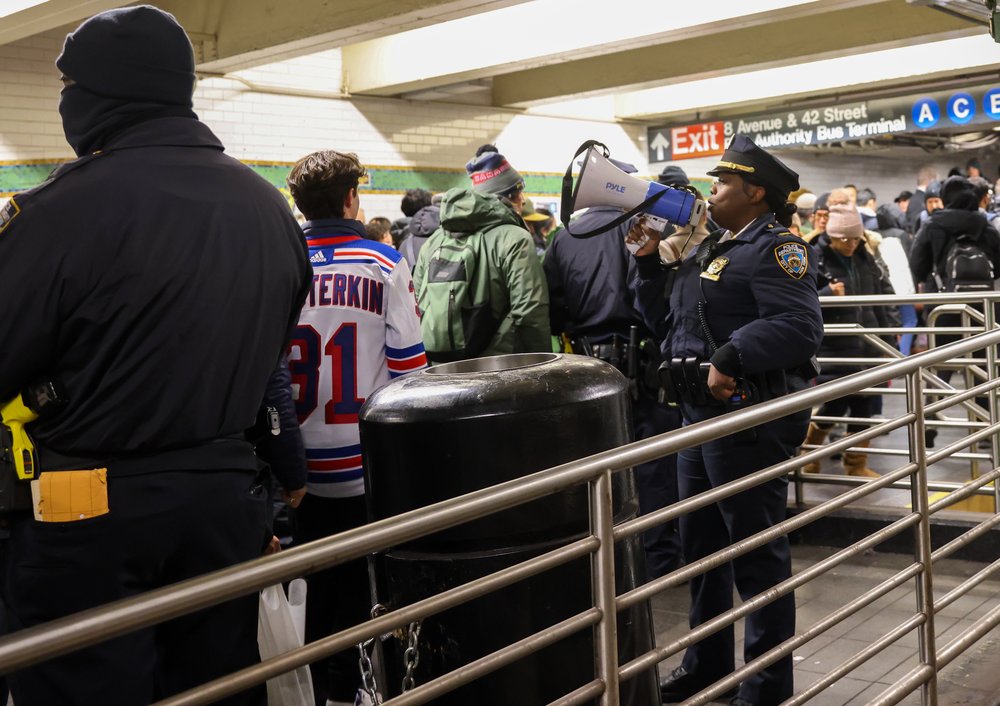Suspected Times Square shooter used a well-worn escape method: the NYC subway system
Feb. 9, 2024, 2:30 p.m.
New York City's subways are often a convenient and cheap form of getaway for criminals.

A man suspected of shooting a bystander and firing at an officer after a botched robbery in Times Square on Thursday night was within reach of police — but was able to flee into the night when he entered New York City’s vast subway system.
The city's transit system is among the world's busiest and most comprehensive, which often makes it a backdrop for crime and a means of escape for criminals. Despite wall-to-wall cameras outside stations and surveillance within them, suspects have been able to elude capture by running through busy stations, entering the tracks, or even simply by boarding trains.
Police chased the suspected shooter into the subway station at the corner of West 47th Street and Sixth Avenue on Thursday night, after he’d allegedly tried to steal from a sports store in Times Square, shot a bystander in the leg and fired at police.
But police lost track of the suspect once he reached the station, according to a briefing by NYPD officials after the incident. He was later seen on surveillance footage making his way onto the tracks, changing clothes and dashing back out of the subway station to parts unknown, said NYPD Chief of Patrol John Chell.
“Subway cameras were instrumental in getting us better pictures of the person we're looking for,” Chell said following a press briefing Friday afternoon.
There are more than 10,000 surveillance cameras in the subway system, the MTA told Gothamist in 2022 shortly after a mass subway shooting at Sunset Park’s 36th Street subway station that injured more than two dozen people.
“The problem with cameras though, is it’s really only good for after the fact, right? It's not really like a preventative tool,” said Christopher Herrmann, an assistant professor in the Department of Law and Police Science at CUNY's John Jay College of Criminal Justice.
Video footage from subway stations often helps police identify suspects in the wake of a crime, but cameras usually can’t help while the chase is still underway: only about half of the MTA’s cameras feed live footage to public safety officials, according to the MTA. The rest only record footage locally, so they need to be specifically accessed after an incident, per the transit agency.
Then it can take hours or days for police to comb through footage of the thousands of people who pass one fixed point in the MTA’s system.
Last month, a man who allegedly shot and killed a school crossing guard on a Brooklyn 3 train got off at a subsequent stop and disappeared. He has still not been arrested.
In October, police spent a day searching for suspect Sabir Jones after he allegedly pushed a 30-year-old woman into a moving E train and fled the subway station at 53rd Street and Fifth Avenue. He was arrested near a PATH train station in Newark.
And Frank James, the shooter accused of injuring 30 people on a train in 2022, eluded capture for more than 24 hours.
“The subway stations are typically what we call 'crime generators,'” Herrmann said. “Whenever you have increased people traffic, you're going to get increased crime, and that's because offenders want to go to places where they can have their selection of victims.”
Although surveillance cameras are present in all 472 of the subway system's stations, they aren't always working properly.
A 2018 audit by the state comptroller’s office found that MTA technicians were behind on camera repairs and maintenance for many cameras in the system. A year later, the agency had stepped up its maintenance routine but still lagged behind on repairs, the comptroller’s office said.
By the time of the Sunset Park subway shooting, some cameras at the station had been broken for days. But other working cameras along the line helped the NYPD identify James, tracking his movements to the East Village where he was arrested a day later.
After the Sunset Park shooting, Gothamist requested camera maintenance and repair records through New York’s Freedom of Information Law. The MTA rejected the request, arguing that sharing this information would compromise riders’ safety.
On Friday, MTA officials said all cameras were up and running throughout the Times Square area before, during and after the incident.
With all the cameras around Times Square in general, Herrmann said it’s only a matter of time before more footage of Thursday night’s suspect emerges. But he also said it’s only a matter of time before Times Square becomes the setting for another crime – given its location, its crowds and the ease of transportation.
“If I'm the bad guy, it makes it cheap for me to get there, and then it makes it cheap for me to get away as well,” Herrmann said. “The subway becomes the main thoroughfare for transit in and around Midtown.”
Stephen Nessen, Charles Lane, and Jaclyn Jeffrey-Wilensky contributed reporting.
Brooklyn subway shooting victim remembered as beloved family member and crossing guard MTA had 'significant problems' in camera system oversight before N train mass shooting: report